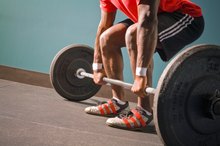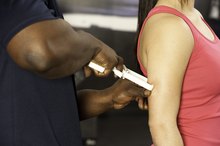How Much More Muscle Mass Does a Male Have Than a Female?
In fitness assessment, muscle mass is regarded as a significant indicator of overall physical strength. Men tend to have approximately 40 percent muscle mass, while women tend to have approximately 30 percent muscle mass. Understanding sex differences in both muscle mass percentage as well as muscle distribution is critical for creating customized training programs and assessing strength for public safety professional or sports. Though muscle mass is correlated with strength, it is not the sole factor that determines someone's ability to perform a task, which may be affected by variables such as flexibility, speed or skill.
Body Composition
Physiologists and fitness experts discuss body composition in terms of fat and nonfat tissues. Nonfat tissues include muscle, bone and organ tissues. Differences in body composition between the sexes are evident even in childhood, though differences increase significantly after the onset of puberty. In the average adult male, the body comprises approximately 43 percent muscle and 15 percent fat. In comparison, the average adult female contains 36 percent muscle and 26 percent fat. Though women have a higher percentage overall of body fat, 15 percent of their body fat is regarded as essential, meaning it is necessary to the healthy functioning of the body. Men, by comparison, have a higher proportional percentage of stored body fat that is not considered essential for health.
Causes
Differences Between Masculine & Feminine Thighs
Learn More
Surges in the female hormone estrogen and the male hormone testosterone are largely responsible for the discrepancies in body composition. During puberty, a dramatic increase in testosterone triggers male bodies to dramatically increase their percentage of lean muscle mass. According to a 2003 review by the "Journal of Adolescent Health," at the end of puberty males have "150 [percent] of the lean body mass of the average female and twice the number of muscle cells." A surge in female estrogen causes the increase in essential body fat in women. Essential body fat is thought to be critical for female fertility, as pregnancy and breast-feeding require higher caloric needs to sustain the health of both mother and baby.
Significance
John LeCuyer, author of "Designing the Fitness Program," contends that body composition, and specifically percentage of fat mass, is the most significant indicator of overall fitness. The increased fat mass in women displaced lean muscle mass, leading to an overall lower percentage of lean muscle mass. Because the sex differences are so consistent, exercise physiologists recommend a higher recommendation for percentage of body fat for women when assessing fitness. For women under 30, recommended body fat is between 14 percent and 21 percent, compared to 9 percent to 15 percent for men. Lower levels of lean muscle mass translate into comparatively lower strength capacity.
Expert Insight
What Is Normal Body Fat?
Learn More
Distribution of muscle mass is also different between men and women. As women tend to store more essential fat in their lower body, strength differences are more pronounced in the upper body than in the lower body. Fitness expert and author of "An Invitation to Health" Dianne Hales notes that women have between 40 percent to 60 percent of the upper body strength of males, but closer to 70 percent to 80 percent of lower body strength. Further, Jared Coburn and Moh H. Malek, exercise physiology experts and editors of the National Strength and Conditioning Association Essentials of Personal Training, note that when muscular strength and ability is measure per muscle unit, sex differences are negligible, suggesting that muscular difference between genders are merely quantitative rather than qualitative.
Related Articles
References
- The Firefighter's Workout Book: Michael Stefano
- Human Anatomy & Physiology: Elaine Marieb et al
- Gender Differences in Body Composition from Childhood to Old Age: An Evolutionary Point of View: Sylvia Kirchengast
- Designing the Fitness Program: A Guide for Public Safety Organizations: John LeCuyer
- NSCA's Essentials of Personal Training: Jared W. Coburn et al.
- Sports Medicine Essentials: Jim Clover
- An Invitation to Health: Dianne Hales
- Journal of Adolescent Health: Growth At Puberty
- Science Daily: Why Do Women Store Fat Differently Than Men?
Writer Bio
Hannah Wahlig began writing and editing professionally in 2001. Her experience includes copy for newspapers, journals and magazines, as well as book editing. She is also a certified lactation counselor. She holds a Bachelor of Arts in English from Mount Holyoke College, and Master's degrees in education and community psychology from the University of Massachusetts.









